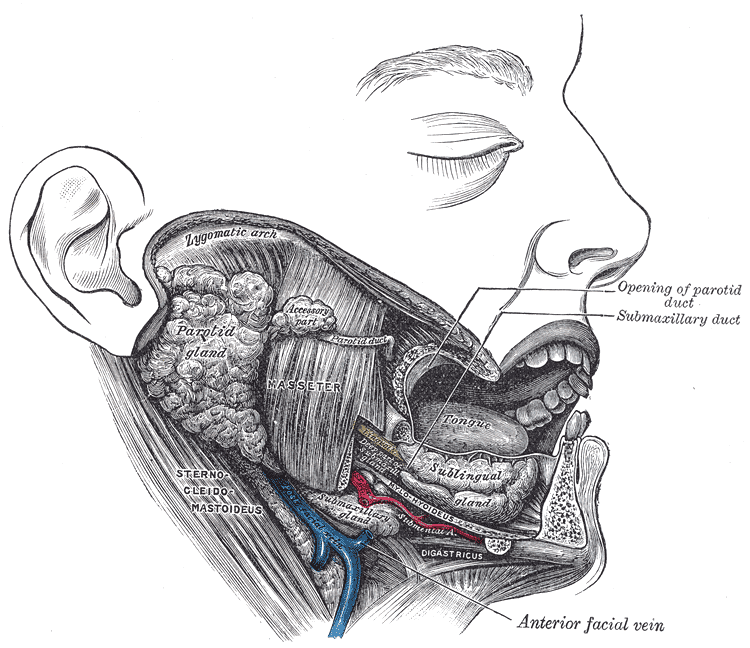
Anatomy
Head and Neck
Sensory innervation of the parotid gland is provided by which of the following nerves:
Answer:
Sensory innervation of the parotid gland is provided by the auriculotemporal nerve (branch of the mandibular nerve).Parotid Gland
Anatomy / Head and Neck / Parotid Region
Last Updated: 11th April 2019
The parotid glands are the largest of the paired salivary glands and are enclosed within the split investing layer of the deep cervical fascia. The parotid glands produce watery saliva and salivary amylase required for food bolus formation and oral digestion.
Anatomical Location
The parotid glands are anterior to and inferior to the lower half of the ear. They extend down to the lower border of the mandible and up to the zygomatic arch. Posteriorly they cover the anterior part of the sternocleidomastoid and continue anteriorly to halfway across the masseter muscle.

Relations of the Parotid Gland. (Image by Henry Vandyke Carter [Public domain], via Wikimedia Commons)
Parotid Duct
The parotid duct leaves the anterior edge of the parotid gland midway between the zygomatic arch and the corner of the mouth. It traverses the masseter muscle and after crossing the medial border of the masseter, turns deeply into the buccal fat pad and pierces the buccinator muscle. It opens into the oral cavity near the second upper molar tooth.
Relations
Several major structures enter and pass through or just deep to the parotid gland including:
- The facial nerve (and its five terminal branches arising within the parotid gland)
- The external carotid artery (and its branches arising within the parotid gland - the posterior auricular artery and its terminal branches the maxillary and superficial temporal artery)
- The retromandibular vein (formed within the parotid gland from the union of the superficial temporal and maxillary vein).
Innervation
Sensory innervation of the parotid gland is provided by the auriculotemporal nerve (branch of the mandibular nerve).
The auriculotemporal nerve also carries secretomotor parasympathetic fibres to the parotid gland; these postganglionic parasympathetic fibres have their origin in the otic ganglion (just inferior to the foramen ovale) which receives preganglionic parasympathetic fibres from the glossopharyngeal nerve.
Sympathetic innervation originates from the superior cervical ganglion.
Clinical Implications
Parotitis refers to inflammation of the parotid gland, usually as a result of an infection. The parotid gland is enclosed in a tough fibrous capsule which limits swelling of the gland, resulting in pain which may be referred to the external ear.
Report A Problem
Is there something wrong with this question? Let us know and we’ll fix it as soon as possible.
Loading Form...
- Biochemistry
- Blood Gases
- Haematology
| Biochemistry | Normal Value |
|---|---|
| Sodium | 135 – 145 mmol/l |
| Potassium | 3.0 – 4.5 mmol/l |
| Urea | 2.5 – 7.5 mmol/l |
| Glucose | 3.5 – 5.0 mmol/l |
| Creatinine | 35 – 135 μmol/l |
| Alanine Aminotransferase (ALT) | 5 – 35 U/l |
| Gamma-glutamyl Transferase (GGT) | < 65 U/l |
| Alkaline Phosphatase (ALP) | 30 – 135 U/l |
| Aspartate Aminotransferase (AST) | < 40 U/l |
| Total Protein | 60 – 80 g/l |
| Albumin | 35 – 50 g/l |
| Globulin | 2.4 – 3.5 g/dl |
| Amylase | < 70 U/l |
| Total Bilirubin | 3 – 17 μmol/l |
| Calcium | 2.1 – 2.5 mmol/l |
| Chloride | 95 – 105 mmol/l |
| Phosphate | 0.8 – 1.4 mmol/l |
| Haematology | Normal Value |
|---|---|
| Haemoglobin | 11.5 – 16.6 g/dl |
| White Blood Cells | 4.0 – 11.0 x 109/l |
| Platelets | 150 – 450 x 109/l |
| MCV | 80 – 96 fl |
| MCHC | 32 – 36 g/dl |
| Neutrophils | 2.0 – 7.5 x 109/l |
| Lymphocytes | 1.5 – 4.0 x 109/l |
| Monocytes | 0.3 – 1.0 x 109/l |
| Eosinophils | 0.1 – 0.5 x 109/l |
| Basophils | < 0.2 x 109/l |
| Reticulocytes | < 2% |
| Haematocrit | 0.35 – 0.49 |
| Red Cell Distribution Width | 11 – 15% |
| Blood Gases | Normal Value |
|---|---|
| pH | 7.35 – 7.45 |
| pO2 | 11 – 14 kPa |
| pCO2 | 4.5 – 6.0 kPa |
| Base Excess | -2 – +2 mmol/l |
| Bicarbonate | 24 – 30 mmol/l |
| Lactate | < 2 mmol/l |

